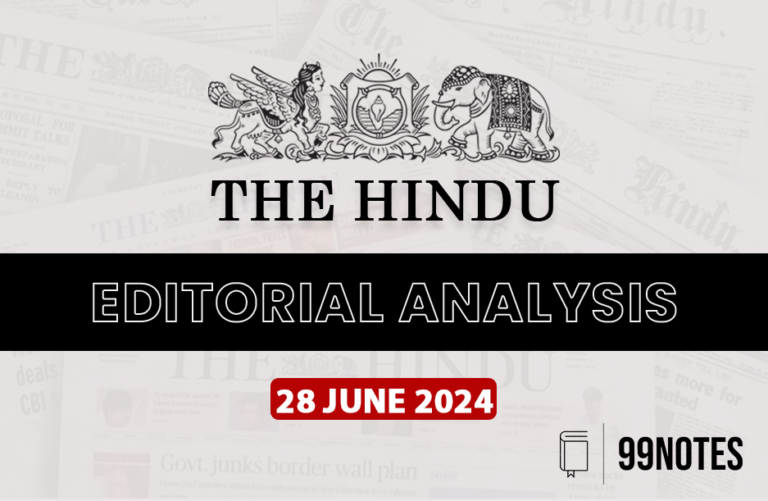7 September 2023 : The Hindu Editorial Notes PDF
The Hindu Editorial
7-September-2023
Daily Current Affairs For UPSC ,The Hindu Editorial Summary
1. India that is Bharat: on a name game.
Topic: GS2 – Indian Polity.
Context:
- The recent decision by the Bharatiya Janata Party (BJP) government in India to use the term “Bharat” instead of “India” in official communication and documents has sparked the controversy.
- The article examines the historical and cultural significance of both terms and raises concerns about the political and divisive nature of this move.
Dual Identity and National Pride:
- Both “India” and “Bharat” have historically been sources of pride and patriotism for Indians.
- These labels have now become politically charged and divisive, with the Bharatiya Janata Party government emphasizing “Bharat” over “”
Constitutional Naming:
- The Constitution of India refers to the country as “India, that is Bharat,” reflecting the contextual use of both terms.
- Preamble: The Preamble of the Indian Constitution begins with the words “We, the people of India…” This is a clear reference to the name of the country, signifying that “India” is the chosen name for the nation.
- Article 1 – Name and territory of the Union: Article 1 of the Constitution states that “India, that is Bharat, shall be a Union of States.” This article explicitly recognizes both “India” and “Bharat” as the names of the country and underscores their coexistence.
Cultural Significance of “Bharat”:
- “Bharat” holds cultural and historical echoes, extending beyond the modern geographical and cultural boundaries of India.
- Its deep roots in ancient sources contribute to its cultural significance.
- The attempt to prioritize one term over the other has created unnecessary divisions in society.
- Laboring to distinguish between the foreign and native elements in a diverse nation like India is counterproductive at times.
Possible implications of the move:
- Political Division: The move may further polarize political and social ideologies, deepening existing divisions in the country.
- Identity Confusion: It could lead to identity confusion and discord, as people may feel pressured to identify with one label over the other.
- Cultural Clashes: Attempts to prioritize “Bharat” might generate cultural clashes and disputes over the interpretation of national identity.
- International Perception: The emphasis on one name over the other could impact how India is perceived internationally, potentially diminishing its global image.
- Administration Challenges: Changing official documents and communication to favor “Bharat” may pose administrative challenges and incur unnecessary costs.
- Symbolic Distraction: The naming issue may divert attention from more pressing national issues, such as economic development, healthcare, and education.
- National Unity: It could undermine efforts to promote national unity by highlighting divisive cultural and linguistic identities.
- Legal Implications: The shift may require legal adjustments, leading to debates over the constitutional use of both terms.
- Influence on Education: The move might influence educational curricula and textbooks, impacting how future generations understand and identify with the nation.
- Impact on Soft Power: It could potentially weaken India’s soft power and influence on the global stage, as the naming debate may be viewed as a sign of internal discord.
Mains Question: Discuss the constitutional provisions related to the naming of India. Also, analyze the implications of recent debates surrounding the use of ‘India’ and ‘Bharat’ in official communication.
Source: https://www.thehindu.com/opinion/editorial/india-that-is-bharat-on-a-name-game/article67277737.ece
2. Bridging the malnutrition gap, the Bemetara way.
Topic: GS2 – Indian Polity.
Nutrition Challenges in India:
- Despite efforts such as mid-day meals, monthly rations, and supplementary programs, nutrition security remains a distant goal in India.
- Lack of knowledge about proper eating and feeding practices, coupled with the prevalence of food myths and processed foods, contributes to malnutrition.
Status of malnutrition in India:
- Stunting: In 2020, it was reported that around 34.7% of children under the age of five in India were stunted
- Wasting: Approximately 17.3% of children under five in India suffered from wasting, indicating acute malnutrition.
- Underweight: About 33.4% of children under five in India were underweight, meaning they had low weight for their age.
- Anaemia: According to the National Family Health Survey (NFHS-4) data, around 58.6% of children between 6 and 59 months and 53.1% of women aged 15-49 were anemic.
Importance of Nutrition Counselling:
- Simplicity in addressing complex nutrition issues is crucial. Counselling individuals on eating habits and monitoring their progress can be highly effective.
- While initiatives like “Jan Andolan” under the Prime Minister’s Overarching Scheme for Holistic Nourishment (POSHAN) Abhiyaan exist, nutrition counselling needs to be uniformly institutionalized.
Bemetara’s Nutritional Challenge – A Case Study:
- Bemetara, a relatively affluent district in Chhattisgarh, faced a high number of Severe Acute Malnutritioned (SAM) children due to improper feeding practices despite access to resources.
- The Potth Laika Abhiyaan, or “Healthy Child Mission,” introduced nutrition counselling and monitoring to address the issue.
- Potth Laika Abhiyaan successfully brought 53.77% of targeted children out of malnutrition within nine months, including 61.5% of Medium Acute Malnutritioned (MAM) children and 14.67% of SAM children.
- The mission proved to be cost-effective, requiring minimal resources.
Reasons for high prevalence of malnutrition in India:
- High prevalence of poverty and income inequality limits access to nutritious food.
- Limited access to quality healthcare services hinders malnutrition management.
- Low levels of education result in poor nutritional knowledge and practices.
- Inadequate sanitation and water supply can cause infections and affect nutrition.
- Cultural practices and traditional beliefs influence dietary habits.
- Suboptimal infant feeding practices contribute to child malnutrition.
- Insufficient access to maternal and child healthcare services impacts nutrition.
- Rapid urbanization leads to unhealthy dietary shifts.
- Gender inequalities limit women’s ability to provide proper nutrition.
Government efforts taken in this regard:
- National Nutrition Mission (POSHAN Abhiyaan): Launched in 2018, POSHAN Abhiyaan aims to reduce malnutrition in India through a multi-sectoral approach. It focuses on improving nutritional outcomes for children, pregnant women, and lactating mothers by providing nutritional education, services, and supplements.
- Integrated Child Development Services (ICDS): Provides nutrition, healthcare, and early childhood services.
- Mid-Day Meal Scheme: This program provides free meals to school children, which not only promotes regular school attendance but also addresses malnutrition by ensuring students receive at least one nutritious meal a day.
- Pradhan Mantri Matru Vandana Yojana (PMMVY): PMMVY provides cash incentives to pregnant women for improved health and nutrition outcomes during pregnancy and childbirth.
- Anemia Mukt Bharat: This initiative aims to reduce anemia prevalence in India through targeted interventions, including iron and folic acid supplementation, dietary diversification, and behavior change communication.
- National Food Security Act (NFSA): NFSA aims to provide subsidized food grains to eligible households, ensuring food security for vulnerable populations.
- Swachh Bharat Abhiyan: Improving sanitation and access to clean drinking water is a critical component of addressing malnutrition, and this program focuses on achieving these goals.
- Rashtriya Kishor Swasthya Karyakram (RKSK): This program focuses on the health and nutrition needs of adolescents, addressing issues such as anemia, menstrual hygiene, and nutrition education.
Way forward:
- Poverty Alleviation: Implement poverty reduction programs and social safety nets to improve economic conditions, ensuring better access to nutritious food.
- Healthcare Strengthening: Invest in healthcare infrastructure, especially in rural areas, to provide quality healthcare services for early diagnosis and treatment of malnutrition-related illnesses.
- Promote Education: Enhance educational opportunities, particularly for women, to improve nutritional knowledge and feeding practices.
- Food Security: Implement policies and programs to ensure consistent access to sufficient, safe, and nutritious food for all, with a focus on vulnerable populations.
- Nutritional Education: Launch campaigns to raise awareness about proper nutrition, including breastfeeding and complementary feeding practices.
- Gender Equality: Empower women through education, employment opportunities, and gender equality measures, as they play a crucial role in family nutrition.
- Healthcare Access: Expand access to maternal and child healthcare services to ensure proper care during pregnancy and early childhood.
- Monitoring and Evaluation: Establish a robust monitoring and evaluation system to track progress in addressing malnutrition and adjust interventions as needed.
Mains question: What are the major government programs and initiatives in India aimed at addressing malnutrition, and how effective have they been in reducing malnutrition rates?
3. For an expanse of blue, with air so clean
Topic: GS3 – environmental pollution
Introduction:
The world stands at a crossroads, grappling with a triple-planetary crisis of biodiversity loss, climate change, and pollution. The urgency to address these pressing issues cannot be overstated, with climate-related disasters becoming increasingly frequent and severe. Among these crises, air pollution emerges as a silent but deadly killer, undermining human health and contributing to a host of environmental challenges.
The Global Challenge:
Air pollution is a grave global concern, with lung cancer alone claiming an alarming 10 million lives worldwide in 2020, according to the World Health Organization (WHO). A report by the Indian National Institute of Health warns that this toll could escalate by another 3.2 million deaths by 2050. South Asia, home to nearly two billion people, faces a daunting reality, hosting nine of the world’s ten most polluted cities. In particular, the city of Delhi epitomizes the relentless struggle against air pollution, where hazardous air quality levels pose a persistent long-term threat to its residents.
Health Impacts:
Air pollution’s health impacts reverberate across communities, affecting the most vulnerable populations, including immunocompromised individuals, pregnant women, children, and the elderly. A Lancet Report reveals that in 2019, 1.67 million pollution-related deaths occurred in India, constituting a staggering 17.8% of total deaths in the country. This grim statistic underscores the magnitude of the problem.
Efforts to Combat Air Pollution:
In response to this dire situation, numerous initiatives are underway worldwide to combat air pollution. These efforts span diverse sectors, including agriculture, technology, urban planning, and education. In India, the PUSA Decomposer, developed by the Indian Agricultural Research Institute, utilizes biotechnology to address agricultural pollution, offering a promising solution. State-level policies such as GRAP 3 (Graded Rapid Action Plan) monitor air quality in hotspots and establish Green War Rooms for effective action. Innovative startups are also repurposing agricultural waste into valuable products, contributing to waste reduction and cleaner air.
Global Best Practices:
International best practices provide valuable insights into addressing air pollution effectively. Cities like Ljubljana (Slovenia), Accra (Ghana), Seville (Spain), Bogota (Colombia), and Medellin (Colombia) exemplify the power of prioritizing human health and environmental sustainability. Car-free zones, green spaces, smart urban designs, electrified public transportation, and nature-based solutions demonstrate positive results. Countries like China, Indonesia, Thailand, and Vietnam are also implementing measures to reduce pollution through clean energy adoption, biomass assessment, and straw burning reduction projects.
International Initiatives:
International organizations play a pivotal role in coordinating efforts to combat air pollution. UNESCO’s initiatives include implementing an internal carbon tax on flight tickets and investing in emission reduction measures. The World Air Quality Project empowers residents to make informed decisions by providing real-time air quality data. Collaboration with UNEP introduces environmentally conscious practices like digital working through the ‘Virtual Meetings’ project and promoting clean air in schools through ‘Clean-Air-For-Schools’ programs.
Youth Advocacy:
Young activists worldwide are taking up the mantle of environmental advocacy, organizing marathons, and using real-time air quality data to raise awareness. Their actions underscore the importance of mobilizing global attention and fostering a sense of urgency.
The Road Ahead:
While international and local efforts are commendable, a specific Sustainable Development Goal (SDG) for ‘Clean Air to Breathe’ remains absent. However, in 2019, the UN General Assembly designated September 7 as the International Day of Clean Air for Blue Skies, signifying a growing global focus on air quality.
Conclusion:
The fight for clean air is an existential battle for the well-being of both humanity and the planet. It is incumbent upon us to act decisively, adopting innovative solutions and implementing best practices to combat air pollution. The question that lingers is whether we will rise to the occasion, becoming torchbearers of change for a sustainable future, or remain passive bystanders.
For Enquiry

7 September 2023 : The Hindu Editorial Notes PDF

Swadeshi Movement and Early Revolutionary activities. Minto-Morley Reforms Mains Test

Various Council Acts, Early Political Activity, Social and Religious Developments Mains Test

Administrative and Economic unification of the country, Including various charter Acts Mains Test

Consolidation of British Empire: Subsidiary Alliance, Paramountcy, Doctrine of Lapse, Maratha and Mysore Mains Test

Advent of European power, Anglo French Wars, British in Bengal. Mains Test

Maratha Empire Mains Test

Bhakti Movement Mains Test

Mughal empire Mains Test

Delhi Sultanate 2 Mains Test
September- The Hindu Editorial 7 September 2023 : The Hindu Editorial Notes PDF The Hindu Editorial
6-September-2023
Daily Current Affairs For UPSC ,The Hindu Editorial Summary
Facebook-f
Twitter
Youtube
1….
Daily Mains test Series Swadeshi Movement and Early Revolutionary activities. Minto-Morley Reforms Mains Test Mains Test Series
Swadeshi Movement and Early Revolutionary activities. Minto-Morley Reforms
Q. The Swadeshi…
Daily Mains test Series Various Council Acts, Early Political Activity, Social and Religious Developments Mains Test Mains Test Series
Various Council Acts, Early Political Activity, Social and Religious Developments
Q1….
Daily Mains test Series Administrative and Economic unification of the country, Including various charter Acts Mains Test Mains Test Series
Administrative and Economic unification of the country, Including various charter Acts.
Q1….
Daily Mains test Series Consolidation of British Empire: Subsidiary Alliance, Paramountcy, Doctrine of Lapse, Maratha and Mysore Mains Test Mains Test Series
Consolidation of British Empire: Subsidiary Alliance, Paramountcy, Doctrine of Lapse,…
Daily Mains test Series Advent of European power, Anglo French Wars, British in Bengal. Mains Test Mains Test Series
Advent of European power, Anglo French Wars, British in Bengal.
Q1. The wars fought…
Daily Mains test Series Maratha Empire Mains Test Mains Test Series
Maratha Empire
Q1. “The 3rd Battle of Panipat did not decide who was to rule…
Daily Mains test Series Bhakti Movement Mains Test Mains Test Series
Bhakti Movement
Q. The Idea of the Bhakti Movement had greater Social implications…
Daily Mains test Series Mughal empire Mains Test Mains Test Series
Mughal empire
Q1. The efficient administrative innovations of Akbar brought stability…
Daily Mains test Series Delhi Sultanate 2 Mains Test Mains Test Series
Rajput states 2 (8th Century to 12th Century)
Q1. ‘Delhi Sultanate was a truly…



